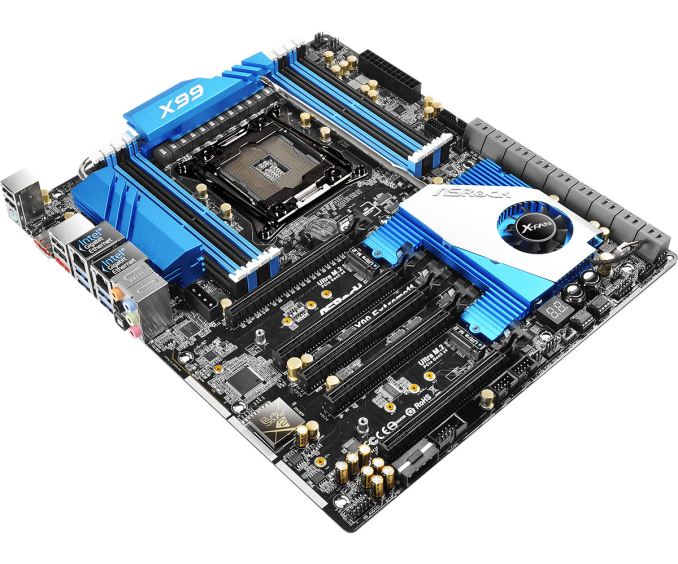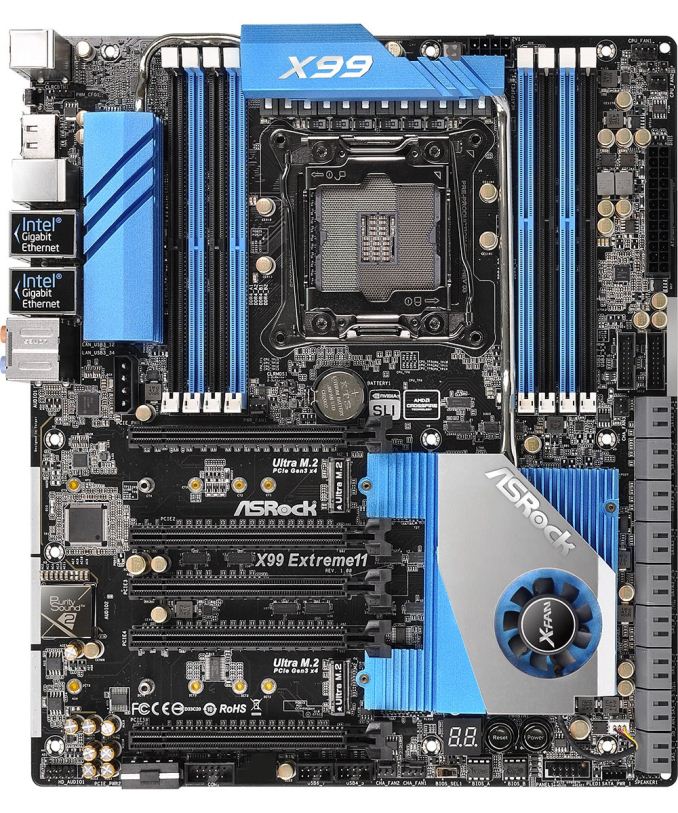ASRock Releases X99 Extreme11: So I Heard You Like Storage
by Ian Cutress on October 9, 2014 7:30 AM EST- Posted in
- Motherboards
- Intel
- ASRock
- LSI
- X99
 (2)_678x452.jpg)
We reviewed the X79 Extreme11 back in September 2012. The concept was simple: divert eight PCIe lanes into an LSI SAS chip for eight more SATA ports with SAS compatibility. Then ASRock released the Z87 Extreme11 which combined the LSI chip with a port multiplier, upping the total from 8+6 to 16+6. The X79 required two PLX8747 chips to also enable x16/x16/x16/x16 + LSI, whereas the Z87 only used one PLX8747 for x8/x8/x8/x8 + LSI.
Now insert the X99 version of the Extreme11. It gets a bit tricky here, because SATA is not the only storage around. Add into the mix that the chipset supports 10 SATA ports on its own then there is the potential for something silly, or awesome, or perhaps a little of both. The X99 Extreme11 uses the same LSI SAS 3008 without the port multiplier, but add in the 10 chipset ports X99 already provides and it gives a total of 18. This LSI chip uses eight PCIe 3.0 lanes and supports RAID 0/1 only, but still allows ASRock to publish 6.1 GBps peak read/write when top end SATA drives are connected to each port.
The X99 Extreme11, similar to the Z87, uses two PLX chips to achieve x16/x16/x16/x16 support along with the LSI chip. To throw some more into the mix, the motherboard also has two Ultra M.2 slots, with both supporting PCIe 3.0 x4 connectivity and 22x110 sized drives. These M.2 x4 slots are still good for 2.8 GBps according to ASRock, and while they won’t be RAID capable in hardware, a software layer might provide an interesting project.
The motherboard will support Xeons with either UDIMMs or RDIMMs, along with ECC support. Networking is provided by two Intel NICs, the I218-V and I211-AT, with support for Teaming. The PCIe slots will support x16/x16/x16/x16 even with the 28-lane i7-5820K, although using that CPU will disable the second M.2 x4 due to the lack of bandwidth.
ASRock is keen to promote their 12-phase power design, which we see paired with large heatsinks. A heatpipe connects all three heatsinks, with the heatsink on the left there only to provide extra surface area. The chipset heatsink is also dealing with the LSI controller, hence the size and the active cooling. Users in the past often express concern about small fans like this, although it can be disconnected if the user has their own sufficient cooling.
The board has eight USB 3.0 ports, six from the chipset and two from an ASMedia controller powering two of the rear IO ports. Also onboard is a COM header, seven fan headers (only two are 4-pin), Realtek ALC1150 audio in Purity Sound 2 and a dual BIOS topology. Because of the use of 4-way PCIe, there are two connectors on board for additional VGA power, although these are molex connectors which I disapprove of. One of them is to the left of the middle of the board, making cable management a nightmare.
The Rear IO has two eSATA ports, both of which are shared with specific SATA ports on the motherboard, meaning only one can work at one time. The back panel also has a PS/2 combination connector, four USB 2.0 ports, four USB 3.0 ports, the two Intel network ports and audio.
In ASRock’s YouTube video promoting the motherboard, they paired the system with an 18-core E5-2699 v3, 128GB of DRAM, four GTX 780 Ti cards, two M.2 x4 drives and 18 SSDs. See you later, I need to sell a kidney and perhaps a lung as well.
I would not be surprised if the X99 Extreme11 ends up being the most expensive X99 motherboard on the market. The two PLX 8747 chips, as well as the LSI 3008, are not cheap for the end-user. Though if a user wants to wire up a large Xeon, a ton of memory, four GPUs, a dozen or more storage devices or any combination therein, then the price of the motherboard might be quite low down on the list. The X79 Extreme11 retailed for $600, so I suspect that this motherboard will be in the same ballpark.
I have requested a review sample, and hopefully we can delve into the interesting PCIe arrangement under the hood. It will be interesting to see how everything is wired up. A full specification list can be found on ASRock's X99 Extreme11 page.







_thumb.jpg)


 (2)_thumb.jpg)








40 Comments
View All Comments
snakyjake - Friday, October 10, 2014 - link
This is exactly what I want to build my personal storage server.it-man - Saturday, October 11, 2014 - link
By dr dre or iMOBOmapesdhs - Saturday, October 11, 2014 - link
Small note Ian, Asrock's page states the LSI controller supports 1E and 10 aswell as 0/1.Btw, do you know if the controller has any included cache RAM? Not having any can
really harm 4K performance through SAS controllers. Really needs to be at least 1GB
for so many ports.
Ian.
Ian Cutress - Saturday, October 11, 2014 - link
Yeah, it's the same controller as previous Extreme11 models, so 1E and 10 are also there (almost everything that supports 0/1 supports 10). It doesn't have any cache RAM, either because the controller doesn't support it or because they can't buy enough to get pricing to be favorable.mapesdhs - Monday, October 13, 2014 - link
That's a real shame. :\
It's easy to get good sequential I/O rates with a SAS controller using large block sizes,
but without the cache the performance for random I/O at small sizes is very limited by
the controller IOPS in the absence of any cache. I've tested various older SAS cards,
up to a P410; once some cache was included, random I/O reached 2GB/sec, and
one could see performance drop off exactly as one would expect once the request
size meant it couldn't fit in the cache.
Hence, unless one's task is aptly served by a no-cache controller, it'd be much more
effective to get something like the ASUS X99E-WS and use a separate SAS card
with cache.
One other thing, am I right in assuming the 128GB RAM capacity is only possible
with a XEON installed? Intel's specs pages state HW-E's max RAM is 64GB.
Ian.
Ian Cutress - Tuesday, October 14, 2014 - link
Correct - 128GB of DRAM with RDIMMs and Xeon. There is a company that makes 16GB DDR3 UDIMMs, but they are not on general sale and work for a limited number of Intel CPUs. As far as we know, no 16GB UDIMM DDR4 modules are on the market. Not sure if that company are investing in DDR4 though. But I suspect in time we will see them from the main DRAM manufacturers, and we'll have to see what the support is like then.mapesdhs - Sunday, October 19, 2014 - link
I had been hoping HW-E would finally move max RAM to at least 128GB, but alas not.This makes it difficult for some solo pros I know working with apps like AE, moving up
to 4K, who really want more than 64GB but can't afford XEON systems. I think Intel is
missing a market opportunity here; with the 64GB limit persisting, it just means some
people can't buy anything that makes sense or is affordable.
Perhaps a higher limit with BW-E or whatever is coming next?
Ian.
nunya112 - Sunday, October 12, 2014 - link
when you get into the Z97 and X99 series. you would expect higher quality and its not there. it stays at that $50 low end. just with high end parts slapped on. where for the same cash. you can get better power. thicker PCB's copper shielded ones. backup Bioses. seperated audio channels on their own dedicated PCB'sAs rock does none of these things well. Buyer BEWARE . if they started releasing quality. I would be praising them. I am not a fanboi. Igo with what's good at the time. and atm Asus is midrange no matter the model. asus has been left behind by MSI and then Gigabyte in that order. MSI has some great boards. but they are dearer than the gigabytes and have less features or cut down features. such as the PWM's and phases etc
mapesdhs - Sunday, October 19, 2014 - link
I guess you've forgotten, their X58 Extreme6 was one of *the* most popular X58 boards
for its time, loads of review sites used it for X58 CPU reviews, and GPU reviews of the day.
And my experiences of X79 have been the opposite of what you describe, excellent
results again and again with the ASUS WS edition, built five of them so far (three 3930K,
two 3960X). Not low quality at all, quite the contrary. Indeed, the WS is basically the same
tech as the ROG series, same oc features/potential, but with better support for RAID cards
& suchlike. I've had numerous Asrock boards in the past, they worked very well, especially
the P55 Deluxe and indeed the Extreme6. They have a reputation for innovation and unusual
board features. Personally I wouldn't touch MSI at all, except for their GPUs which I do like
(I have six of their 3GB 580 LXs).
Ian.
akula2 - Monday, October 20, 2014 - link
Are you planning to do reviews for Asrock X99 WS and Asus X99-E WS?I'm an Asus consumer since 'Supercomputer' board says, but never used Asrock WS boards. I'm kinda stuck because of lack of quality reviews because:
~$200 price difference between them
5690X and Xeon performance
PCIe limitations on those boards
DDR4 optimal frequency at CPU Turbo range? E.g., buying 2666Hz makes sense or stick to 2133?
I've so many unknown questions. And there is:
Asus OC socket which really makes me uncomfortable
Asus X99 Deluxe boards and 5960X saga. Does WS board has any issue? I don't know...
And, another big one is: release of Maxwell based Titan Black II, Quadro and Tesla cards?
First the first time in many years, I'm not getting enough courage to spend six-digit budget on ten ultra workstation builds (five 5960X and five Xeons based). Perhaps I might push everything to another 4-5 months instead of building them during with the upcoming holiday.
What do you suggest in my case?